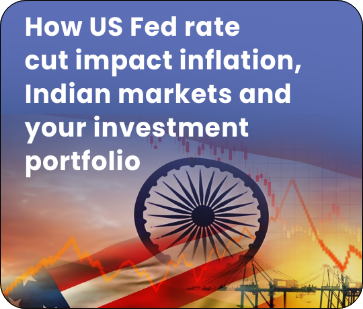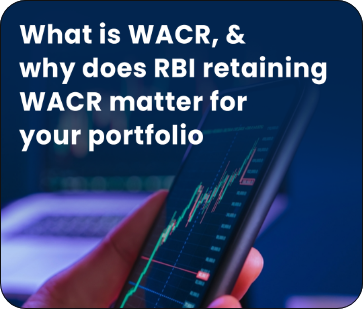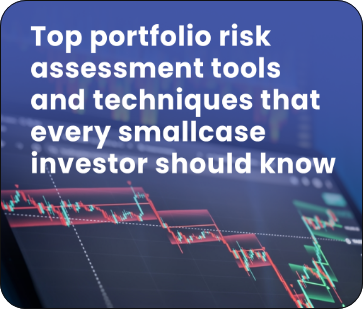
Why investors who resist panic selling win in the long run?
Every market cycle tests investors. When prices fall sharply, your first instinct will be to "cut losses".
This sinking feeling leads to selling, which is a natural response, but not the smart one. Such panic selling feels like the safest move, but history proves it rarely is.
Whether you're building wealth through mutual funds, stocks, or a smallcase investment, staying calm during drawdowns often makes the difference between short-term regret and long-term success.
In this article, we dig deep into this to understand why investors who resist panic selling win in the long run.
We will also explore what lessons you need to learn to have the right winning mindset in the first place, strategies to stay invested, and much more.
Table Of Contents:
The psychology of drawdowns: How it traps you?
Drawdowns are emotionally taxing because they activate fear more strongly than gains activate joy. Behavioural finance studies reveal that loss aversion, the tendency to feel losses twice as intensely as gains, pushes investors into irrational decisions.
- When markets fall, investors often view temporary declines as permanent damage.
- News headlines amplify this fear, making short-term volatility look like the start of a long-term collapse.
- Herd behaviour kicks in, with investors copying what others do, which intensifies sell-offs.
Remember March 2020, when global indices crashed during the pandemic. Investors who sold to "cut losses" often missed the sharp recovery that followed within months. Those who stayed invested saw portfolios bounce back strongly.
So basically, these drawdowns are not just financial but deeply psychological traps. Recognising this bias is the first step to overcoming it.
Why does panic selling win the moment but lose the war?
Selling in a slump feels like control. You stop the bleeding. You also lock in losses and set up a second decision, such as when to buy back.
Most investors miss the sharpest part of the rebound because the best days cluster around the worst days.
Missing just a handful of the market's best days can slash long-term returns; many of those best days occur during bear markets or early in new bull phases.
India shows the same pattern, where missing just a handful of the best days on Dalal Street can sharply reduce overall wealth over the long term.
That's why panic selling "wins" the day but "loses" the decade. You capture relief now and surrender compounding later.
Top lessons for a winning mindset
Here are some top lessons for a winning mindset that you should integrate into your strategy and overall approach:
- Volatility is part of equity returns: Even strong markets deliver 10–15% pullbacks. Treat swings as the cost of growth, not a sign your plan is broken.
- Time in the market beats timing: Staying invested captures recoveries you cannot predict day-to-day. Missing the best bursts of performance damages long-run CAGR.
- Seven-plus years change the odds: Indian equity studies show that longer horizons greatly reduce the chance of poor outcomes and improve the odds of double-digit returns.
- Goals over quotes: Match your review cycle to your horizon. Long-term goals do not require daily checks.
Also, choosing the best smallcase company is another underrated but highly strategic step you can take to transform your investment journey entirely.
Not just returns, but look for the company with a research process, portfolio curation, rebalancing discipline, risk management, and a focus on long-term wealth creation.
What's the hidden cost of exiting early?
You see the booked loss but rarely notice the hidden costs of existing early. Here's what you need to mind of:
- Timing both when to sell and buy is hard and poses risks: You need two perfect calls, the first is when to sell, and the second is when to buy back. Most investors re-enter late and pay up.
- It takes up opportunity cost due to missing market growth: Idle cash earns little while compounding moves on without you.
- Frequent trades increase taxes and costs: Short-term churn adds taxes and costs that don't show up in index charts.
- Panic selling deteriorates confidence and discipline: Each panic exit makes the next one more likely. You build a habit of reacting, not investing.
If you look at the studies of rolling returns in India, you will see the same trend. Longer holding periods improved the likelihood of positive outcomes across indices and funds, which means early exits often swap temporary volatility for permanent underperformance.
Best practical strategies to stay invested
Now, you know the downsides of panic selling, but how to remain invested in tough times. Here are some practical strategies to help:
Set clear rules before the volatility hits
Make sure to decide in clear words: "I hold unless the business thesis breaks." Write what breaks a thesis, it can be earnings downgrades, leverage spikes, governance issues, but not price alone.
Invest step by step to reduce timing risk
You should spread entries over time with SIPs or staged allocations. This keeps you moving forward when emotions push you to wait. It also builds positions at a blended cost without chasing perfect timing.
Balance your portfolio with large caps and buffers
You have to pair mid and small exposure with large caps and cash buffers. You create room to survive shocks without forced selling.
Diversify across sectors to reduce concentration risks
You must avoid single-theme concentration. Quality across industries cushions drawdowns when one pocket stumbles.
Rely on using checklists before deciding to sell
Before you sell, you must ask yourself- Has the long-term story changed? Am I reacting to price or facts? Will I buy this back higher? You must have a checklist of questions to ask before making a decision.
Limit market noise to avoid emotional trading
The best idea to limit the market noise is to reduce screen time in volatile weeks. Shift to a monthly review cadence unless your thesis changes.
Depend on research-driven smallcase portfolios to remove emotion
Expert-curated smallcase portfolios bring a defined process, scheduled rebalancing, and documented thesis updates. That structure helps you separate signal from price moves when fear peaks.
For example, PINC Classic Compounder Fundamental focuses on stocks with growth potential of 15–20% over a 3–5 year horizon, with medium volatility.
Conclusion
Selling in fear feels safe, or so you think! But the data says otherwise. In fact, oftentimes it costs you more than it would with the risk. Markets store their biggest gains near their biggest drops.
The investors who win accept volatility, follow a process, and stay present for the turn. That is how you keep compounding intact.
At PINC, we understand that and offer research-backed, thoughtfully curated smallcase portfolios that aim for quality, clarity, and discipline.
Our focus is on businesses with durable fundamentals where we rebalance with intent.
If you want smallcase investment options you can actually hold through cycles, we're here to help you stick with the plan, not the panic. Start your investment journey today!
Related Articles

How will the US Fed rate cut impact inflation, Indian markets and your investment portfolio?
US Fed rate cuts influence Indian markets, currency trends, and smallcase stocks. Explore sectors that benefit, risks, and smart investment strategies for 2025.
Know more
What is WACR, and why does RBI retaining WACR matter for your portfolio?
Understand WACR and RBI's revised liquidity framework. Learn how these monetary policy changes impact your smallcase investment and portfolio returns.
Know more
‘Bite-sized’ smallcase investments: Low entry-cost portfolios for new and young investors
Making investment even easier and simpler with ‘bite-sized’ smallcase portfolios. Here’s a guide for beginners on how to start and build long-term wealth.
Know more
Top portfolio risk assessment tools and techniques that every smallcase investor should know
Learn about the top portfolio risk assessment tools and techniques that every smallcase investor should know to analyse and manage the potential risk, and how financial advisors help in this effectively.
Know moreMeet the people
we served!
PINC Compounder Smallcase has simplified my investment journey. Seriously, investing has never been easy for me! Here in a single click, I could access a balanced portfolio. Thanks PINC.
Mr. Akhilesh
I was hesitant about investing, but PINC Smallcase changed that. Talking to their team and looking at their growth gave me confidence. I've seen my investments grow steadily since then. I'm impressed!
Devendra Palan
As someone with limited knowledge about the stock market, I found Pinc smallcase to be a reliable and accessible platform. Their detailed reports and analysis have given me a deeper understanding of the stocks in my portfolio. I feel confident in managing my investments.
Pratik Gandhi

Subscribe to our email list
Sign up for Expert Insights
Your Gateway to Smarter Wealth
Management!
Looking to grow your wealth with
PINC Smallcase?